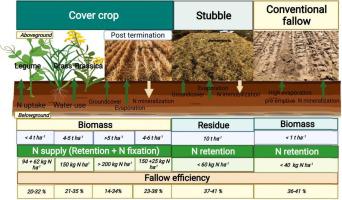Agriculture, Ecosystems & Environment ( IF 6.6 ) Pub Date : 2022-06-10 , DOI: 10.1016/j.agee.2022.108052 Ismail Ibrahim Garba , Daniel Fay , Reni Apriani , Dk Yusrina Pg Yusof , Danqing Chu , Alwyn Williams

|
Conventional dryland cropping systems rely upon frequent and lengthy fallow periods to conserve soil water and mineral nitrogen to stabilize crop production. However, this is associated with depletion of soil organic matter and decreased fallow efficiency. Intensifying cropping systems by planting cover crops has been touted as a means to stem soil organic matter loss and improve fallow efficiency. We investigated whether the manipulation of cover crop functional trait diversity and sowing proportions (utilizing Poaceae, Fabaceae, and Brassicaceae) could provide complementary functions that improve soil water and mineral N management during fallow. Grass-legume mixtures represented the best compromise between biomass production (> 4000 kg DM ha˗1), N retention (142 kg N ha˗1), N supply via biological N fixation (35 kg N ha˗1) and maintained an additional 70 mm of water at the end of fallow period. Regardless of functional trait type, cover crops increased N retention but maintained similar soil mineral N content at the end of fallow period. However, soil water effects were functional trait-specific, and there were significant soil water deficits with brassica-dominated cover crops. Soil water accumulation post cover crop termination was significantly higher in cover crops compared with conventional fallows, but the overall fallow efficiency was higher in the conventional fallow. This study demonstrates that cover crops are not universally beneficial, and careful selection of cover crop functional traits in mixtures could enhance fallow soil water and N management in semi-arid sub-tropical drylands.
中文翻译:

休耕替代覆盖作物影响半干旱亚热带环境中的土壤水和氮动态
传统的旱地耕作系统依靠频繁而漫长的休耕期来保存土壤水分和矿质氮以稳定作物生产。然而,这与土壤有机质的消耗和休耕效率的降低有关。通过种植覆盖作物来加强耕作系统被吹捧为阻止土壤有机质流失和提高休耕效率的一种手段。我们调查了覆盖作物功能性状多样性和播种比例(利用禾本科、豆科和十字花科)的操纵是否可以提供补充功能,以改善休耕期间的土壤水分和矿质氮管理。草豆类混合物代表了生物量生产(> 4000 kg DM ha ˗1)和氮保留(142 kg N ha ˗1 )之间的最佳折衷), 通过生物固氮提供 N (35 kg N ha ˗1) 并在休耕期结束时保持额外的 70 毫米水。无论功能性状类型如何,覆盖作物增加了氮保留,但在休耕期结束时保持了相似的土壤矿物氮含量。然而,土壤水分效应具有功能性状特异性,并且以芸苔属植物为主的覆盖作物存在显着的土壤水分亏缺。与常规休耕相比,覆盖作物终止后的土壤蓄水量显着高于常规休耕,但常规休耕的整体休耕效率更高。该研究表明覆盖作物并非普遍有益,仔细选择混合物中的覆盖作物功能性状可以加强半干旱亚热带旱地的休耕土壤水和氮管理。



























 京公网安备 11010802027423号
京公网安备 11010802027423号